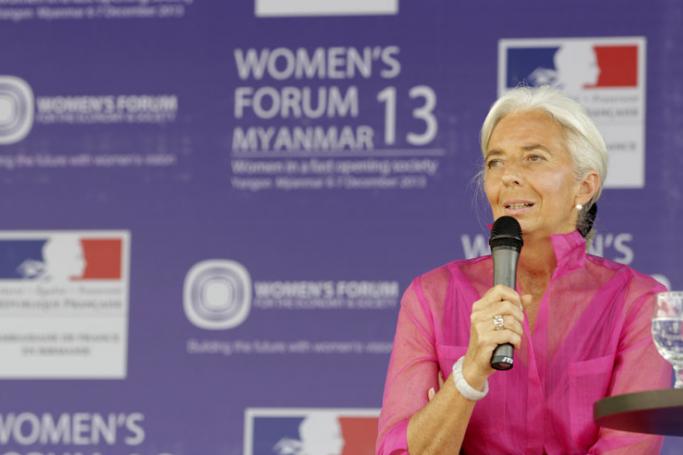The International Monetary Fund has just released the findings of its Article IV consultation with Myanmar in which it welcomes the country’s economic rebound but cautions about the downside risk.
On March 12, 2018, the Executive Board of the International Monetary Fund (IMF) concluded the Article IV consultation with Myanmar, the findings of which were released on 28 March.
The following is the full statement from the IMF:
Myanmar’s economy stabilized in 2016/17. The new government saw a challenging first year with lower-than-expected growth of 5.9 percent in 2016/17 mainly due to weak agriculture production and exports, and temporary suspension of some construction projects in Yangon. The fiscal consolidation to about 2.5 percent of GDP deficit in 2016/17, from the election year deficit of about 4.5 percent of GDP, helped to reduce central bank financing of the deficit and imbalances. Inflation moderated to 6.8 percent, and the current account deficit fell to about 3.9 percent of GDP in 2016/17 from 5.1 percent 2015/16. The current account deficit continues to be mainly financed by FDI, with the real exchange rate and international reserves (at 3.2 months of prospective imports) broadly stable.
The medium-term macroeconomic outlook remains favourable. Growth is expected to rebound to 6.7 percent in 2017/18 mainly supported by a recovering agriculture sector and exports. Higher fiscal spending anticipated in the second half of 2017/18 due to buoyant tax revenues will also support growth. While the direct economic impacts of the humanitarian crisis in Rakhine State have been largely localized, the social costs and full impacts of the crisis are yet unfolding. Over the medium term, growth is expected to gradually pick up toward the estimated potential rate of about 7.0 percent to 7.5 percent, reflecting continued large FDI inflows and an improvement in public investment spending and efficiency.
Risks are tilted to the downside. The banking sector needs to adjust to important new prudential regulations after a period of rapid credit growth. The humanitarian crisis in Rakhine state could affect development finance and investor sentiment. Additional risks stem from commodity prices, potentially volatile global financial markets, exposure to spillovers from China, and the risk of natural disasters. On the upside, implementation of a more detailed strategic reform plan and higher infrastructure investment would raise potential growth.
Executive Directors welcomed the rebound in Myanmar’s economy and its favourable long‑term growth prospects. However, downside risks have increased, including from the humanitarian crisis in Rakhine State. Expressing their strong concern, Directors highlighted the need for early and tangible progress toward peace and regional inclusion, to improve conditions in affected areas and to realize Myanmar’s strong potential for inclusive growth. Directors also called for a second wave of reforms to help sustain Myanmar’s economic transition and growth take‑off. They commended the release of Myanmar’s Sustainable Development Plan (MSDP) and recommended that the MSDP be expanded to address reform sequencing and regional disparities, including the humanitarian crisis in Rakhine State.
Directors underlined the need for sufficient resources to achieve the SDGs, while ensuring that fiscal policy remains anchored on debt sustainability and a lowering of central bank financing of the deficit. Directors welcomed the sustained progress on domestic revenue mobilization, and saw scope for further expenditure rebalancing and improvement in public financial management. Directors cautioned against excessive use of tax amnesties and incentives, which risk eroding the revenue base. State economic enterprises and large infrastructure projects, including PPPs, should be closely and transparently monitored to minimize fiscal risks and debt distress.
Directors noted the emergence of banking sector risks and supported steps toward improved financial sector regulation. They also supported the implementation of the Banking Sector Action Plan to respond to emerging risks, promote financial deepening, and strengthen the resolution framework. While Directors supported financial sector and interest rate liberalization, they agreed that this should proceed at a pace commensurate with the central bank’s capacity to regulate and supervise.
Directors encouraged the authorities to formally adopt the new transactions‑based exchange rate mechanism. To enhance market certainty, the Central Bank of Myanmar (CBM) should formally adopt the new transactions‑based mechanism for setting the reference exchange rate. Directors also underlined the need to develop the interbank foreign exchange market and allow greater exchange rate flexibility to cushion against external shocks.
Directors considered the current stance of monetary policy as appropriate. They encouraged further development of the monetary framework, including deeper debt and interbank markets. Directors stressed the need to continue phasing out CBM financing of the fiscal deficit, and welcomed the decline in the level of CBM financing in 2016/17.
Directors underscored the central role of capacity development in Myanmar’s economic transition and growth. They strongly supported the Fund’s continuing strong efforts in this area and the close alignment with surveillance priorities. Directors commended the steady progress toward improving statistics, and welcomed Myanmar’s participation in the Enhanced General Data Dissemination System.
Directors noted that Myanmar will soon be in a position to fully meet its obligations under Article VIII. They encouraged continued progress to remove the last remaining exchange restriction and multiple currency practice.
You are viewing the old site.
Please update your bookmark to https://eng.mizzima.com.
Mizzima Weekly Magazine Issue...
14 December 2023
Spring Revolution Daily News f...
13 December 2023
New UK Burma sanctions welcome...
13 December 2023
Spring Revolution Daily News f...
12 December 2023
Spring Revolution Daily News f...
11 December 2023
Spring Revolution Daily News f...
08 December 2023
Spring Revolution Daily News f...
07 December 2023
Diaspora journalists increasin...
07 December 2023
Myanmar Suu Kyi supporters blocked from campaigning in Thailand












